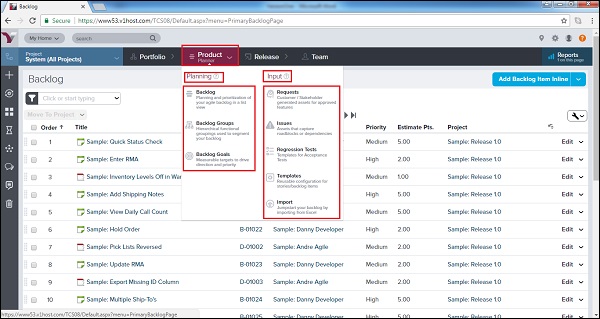
- VersionOne - Home
- VersionOne - Introduction
- VersionOne - Features
- VersionOne - Free Trial Access
- VersionOne - Login
- VersionOne - Dashboard
- VersionOne - Invite Users
- VersionOne - Add a Project
- VersionOne - Portfolio Planner
- VersionOne - Product Planner
- VersionOne - Backlog
- VersionOne - Story
- VersionOne - Edit Story
- VersionOne - Defects
- VersionOne - Edit Defects
- VersionOne - Release Planner
- VersionOne - Sprint Planning
- VersionOne - Sprint Scheduling
- VersionOne - Detail Planning
- VersionOne - Issues
- VersionOne - Task
- VersionOne - Templates
- VersionOne - Import Data
- VersionOne - Team Rooms
- VersionOne - Storyboard
- VersionOne - Testboard
- VersionOne - Taskboard
- VersionOne - Filters
- VersionOne - Search
- VersionOne - Conversation
- VersionOne - Collaboration
- VersionOne - Notification
- VersionOne - Estimably
VersionOne - Product Planner
Product Planning is the actual start of the project. In this phase, Product Owner works with backlog items to prioritize, groom and estimate.
In this chapter, we will discuss how to plan the backlog items and how to manage them in the sprint level.
Points to Note
In this section, we will go through some important points that need to be considered in product planning.
Product Planning is the activity where Product Owners identify, organize and groom the Backlog to prepare it. The development/testing/BA team(s) works on this aspect. If planning does not happen properly, sprint works affect the productivity and timeline of project..
It involves managing the backlog items, test sets and defects that define the updates going into the product.
These items form the backlog and are ranked by priority so they can be scheduled into releases/projects and sprints.
-
Product Planner is divided into two sections Planning and Input. The Planning section consists of −
Backlog − It is used for planning and prioritization of Agile backlog in list view.
Backlog Groups − It provides the hierarchical functional groupings used to segment the backlog.
Backlog Goals − It provides the measurable targets to drive the project effort into a proper direction.
-
The input section consists of −
Requests − These are generated by customers/stakeholders who approve the assets/backlog.
Issues − It captures roadblocks or dependencies or other issues that affect the project directly or indirectly.
Regression Tests − These are templates for Acceptance Tests.
Templates − It is the standard template that is used to configure stories/defects/backlog items.
Import − It is the standard template that is used to configure stories/defects/backlog items.
